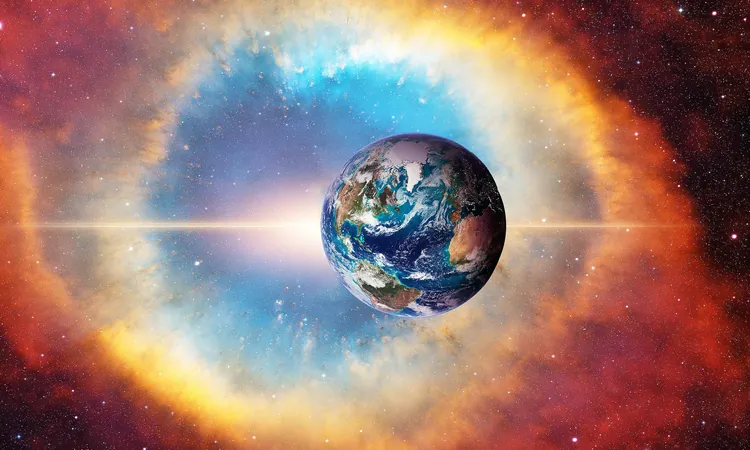
Cosmic Catastrophes: The True Culprits Behind Earth's Mass Extinctions!
2025-03-17
Author: Ken Lee
Cosmic Catastrophes: The True Culprits Behind Earth's Mass Extinctions!
Human civilization often prioritizes terrestrial threats, but startling evidence suggests that our planet's past dangers may have originated from the cosmos. Recent research shines a light on how explosive stellar events could have dramatically influenced Earth's biological history.
For years, scientists have speculated about the impact of cosmic phenomena on our planet's ecosystem. A burgeoning area of interest focuses on the potential correlation between powerful stellar explosions—specifically supernovae—and major evolutionary shifts throughout Earth’s history.
In a groundbreaking study conducted by researchers from Keele University and the University of Alicante, a compelling link has been unearthed between the frequency of stellar explosions and two significant ancient mass extinctions. Dr. Alexis Quintana and Dr. Nick Wright meticulously analyzed the distribution of massive stars in our galaxy to reveal a pattern: supernova events occurring near Earth seem to coincide with two notable extinction events—about 372 million years ago and 445 million years ago.
These extinction events, known as the late Devonian and Ordovician extinctions, drastically altered Earth's biodiversity. During the Devonian Period, approximately 70 percent of all species went extinct, while the Ordovician extinction erased around 60 percent of marine life. Historically, researchers have sought a definitive cause for these calamities, with many pointing to ozone layer depletion, but the latest findings suggest that cosmic explosions might have played a pivotal role.
Dr. Wright elaborates, stating that supernovae may have weakened the ozone layer, exposing life on Earth to harmful ultraviolet radiation. The study's findings indicate that massive stars produce both the elements that foster planetary formation and the potentially life-threatening bursts of energy upon their deaths.
The research also underscores the risks posed by OB stars—massive giants within about 3,260 light-years of our sun. Analysis revealed that the supernova rate in this region correlates with historical mass extinction events. The implications of a nearby supernova's impact are staggering: potential atmospheric damage could lead to acid rain and life-threatening solar radiation exposure.
As Dr. Wright cautions, "If a massive star were to explode as a supernova near Earth, the results could be catastrophic for life." While the astronomical occurrences of supernovae are relatively infrequent—happening about once or twice per century in the Milky Way—stars like Antares and Betelgeuse are predicted to deplete their nuclear fuel within the next million years, albeit at distances that likely mitigate their effects on Earth.
This research not only enhances our understanding of mass extinctions but also holds implications for studying black holes and neutron stars formed after stellar collapse. The data gathered is crucial for improving gravitational wave detectors, allowing astronomers to better predict the frequencies of these cosmic events and their potential repercussions.
As scientists continue to explore the relationship between supernovae and Earth’s environmental stability, numerous questions remain. How does our atmosphere recover from spikes in solar radiation? Do terrestrial and aquatic life forms respond differently to these cosmic events?
While the path of evidence is ongoing, it increasingly paints a picture where ancient extinction events may harbor cosmic roots. Researchers are committed to further examining the cosmos for additional insights, highlighting the intricate ties between our planet and the universe beyond.
Stay tuned for more cosmic discoveries that could redefine our understanding of Earth's history!


 Brasil (PT)
Brasil (PT)
 Canada (EN)
Canada (EN)
 Chile (ES)
Chile (ES)
 Česko (CS)
Česko (CS)
 대한민국 (KO)
대한민국 (KO)
 España (ES)
España (ES)
 France (FR)
France (FR)
 Hong Kong (EN)
Hong Kong (EN)
 Italia (IT)
Italia (IT)
 日本 (JA)
日本 (JA)
 Magyarország (HU)
Magyarország (HU)
 Norge (NO)
Norge (NO)
 Polska (PL)
Polska (PL)
 Schweiz (DE)
Schweiz (DE)
 Singapore (EN)
Singapore (EN)
 Sverige (SV)
Sverige (SV)
 Suomi (FI)
Suomi (FI)
 Türkiye (TR)
Türkiye (TR)
 الإمارات العربية المتحدة (AR)
الإمارات العربية المتحدة (AR)